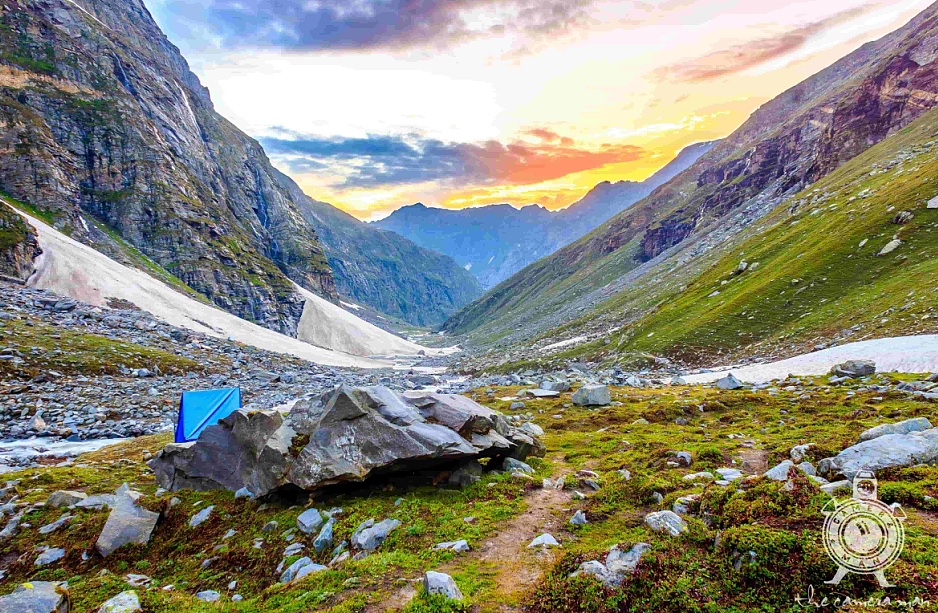Ultimate Guide To Hampta Pass Trek

The Hampta Pass Trek is perfect for someone who enjoys mountains and wants to go on an adventure in the midst of them. This trek’s most appealing feature is its relatively high elevation, which makes it ideal for beginner and inexperienced mountaineers. A trekker can cross a maximum altitude of around 14000 feet on this trek. There is no pressing need for acclimatisation.
Crossing over from the familiar views of the lush green Himalayan mammoths, one reaches the top of the Hampta Pass from the Manali side and is greeted by the bleak deserted landscape of Lahaul and Spiti Valley! The sheer drama is captivating, and you’ll have to think fast to figure out what just happened!
As compared to its rivals, the Hampta Pass Trek is certainly on the easier side. Although the adrenaline rush and jaw clenching sensation may not be familiar to experienced trekkers, it is an ideal way for beginners to get into the swing of things.
Of course, this isn’t to suggest that experienced hikers won’t enjoy the trip; the sheer range of views will be well worth the effort – from glacial valleys to lush green pastures, the journey has it all.
It is surrounded on one side by grasslands and splendours, and on the other is the raw deserted splendour of Spiti. Normally, people cross the Hampta Pass and proceed to Chandratal Lake. If the roads are open on the last day, you’ll also have the opportunity to see the magnificent Chandrataallake.
For the Hampta Pass Trek, you won’t need to think about acclimatisation. However, since you will be climbing to a height of 14000 feet, it is always a good idea to take it easy and enjoy the scenery.
Weather conditions at Hampta Pass:
You will get to experience the fairy-tale of Himalayan weather during the summer or monsoon season, which is the most famous time for the trek. Hopefully, there will be snow in the area at the start of the season.
Snow begins to melt around July, but rain can be expected on the Manali side starting in July. Spiti Valley does not have monsoons as we know them, so you will be able to enjoy bright sunshine (as well as metaphorical rainbows, unicorns, and butterflies) during this time!
The maximum temperature on the Hampta Pass trek is between 12 and 20 degrees Celsius, while the minimum temperature is between -6 and 4 degrees Celsius.
When is the right time to climb up Hampta Pass?
This trek takes place from June to September, but the best time to go is from mid-June to September, except monsoon season. It is possible that the roads to Chandrataal Lake will be closed in the first month of June.
Seeing the crescent moon-shaped lake with the sun reflecting over its surface is an once-in-a-lifetime opportunity that should not be missed. Otherwise, you can trek up the Hampta Pass during this time.
Timeframe and Location:
The Hampta Pass Trek begins in Manali, Himachal Pradesh, and lasts 5-6 days. This lovely hike is surrounded by spectacular waterfalls, trees, and maple woods. It’s ideally suited for beginners because it has just the right amount of adventure. As a result, the Hampta Pass connects Manali’s “Valley of Gods” with Spiti Valley’s “Middle Land.”
Of course, hitting the top and passing the Hampta Pass is an unforgettable experience. Few people have the opportunity to visit such sites. The most personal and valued bonds of friendship with your fellow adrenaline junkies; the physical strength and mental obstacles you get to conquer (a.k.a. friends for life). I’m actually realising what it means when people say the mountains are calling, and I MUST GO! – It’ll be a magical journey!
The tour begins in Manali’s scenic area and brings visitors to unique and beautiful locations such as Chikka, the first stop on the excursion. The trek also passes across vast fields of Rhododendron, Oak, and Pine trees. Along the way, you’ll pass by the Hampta River. The Hampta people use this river as a bridge to get to Lahaul and Spiti Valley. The beginning of the Hampta Pass Ranges in Prini Village. The trail then ascends to provide a change of scenery. The path is surrounded by lush greenery and stunning scenery.
This itinerary for the Hampta Pass Trek is a comprehensive 8-night, 9-day itinerary. The tour includes a look at the best of nature’s beauty. In a nutshell, it’s the ideal trek for nature lovers looking for an adrenaline rush.
Highlights of the Hampta Pass Trekking Tour:
Every day, enjoy delicious and healthy meals while admiring the immaculate and picturesque alpine-like Chandratal Camp under the star-studded sky.
Take advantage of the magnificent views of the PirPanjal Ranges.
Crossing some of the high mountain passes can be exciting.
When is the best time to go on the Hampta Pass Trek?
From mid-June to mid-October is the best time to trek to Hampta Pass. In the early days of the season, there is a possibility of seeing snow on the high passes, but it melts entirely by August. During the monsoons, rain is forecast in the Kullu-Manali valley, but the sun will shine brightly in Spiti as normal. During the day, the temperature will likely be between 12 and 20 °C, while at night, the temperature at the highest campsite will be between -2 and 6 °C. A little snowfall is possible in the latter part of the trekking season (Sep – mid-Oct). The daytime temperatures will range from 12 to 18 degrees Celsius, and the evenings will get colder as the day progresses.
The daytime temperatures will range from 12 to 18 degrees Celsius, while the evenings will be cold, with temperatures falling to 4 to -6 degrees Celsius.
You will find the Hampta Pass Trek in the following places:
The Hampta pass is located in Himachal Pradesh, east of Manali and the PirPanjal range. While on the Hampta Pass Hike, the southeast ridge can be seen clearly. The Hampta Pass, at an elevation of 4,268 metres, serves as a bridge connecting the Kullu valley and Lahaul.





